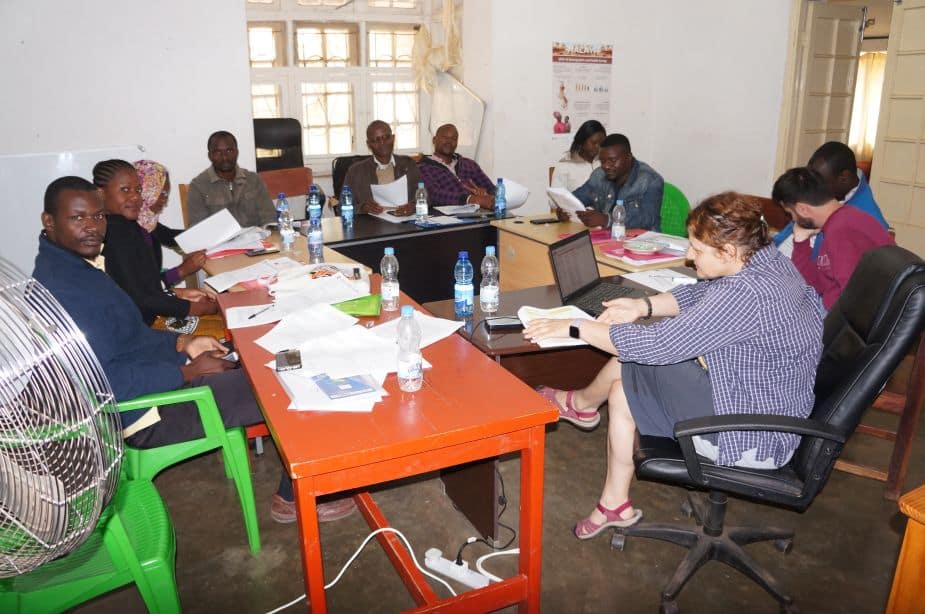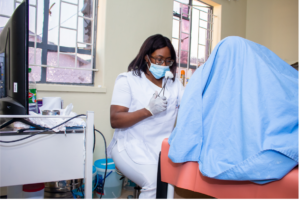
Traces of a hard life: Mental health problems on the rise in sub-Saharan Africa
If we look at the distribution of depression and anxiety in affluent, industrially developed nations, we see an inverted U running from young to old. The plateau with the highest values covers people in their middle age, indicating that the age group that generally has the highest workload and responsibility is most affected by anxiety and depression. By contrast, the curve falls with increasing age. Senior citizens in industrialised countries are comparatively less likely to suffer from depression or anxiety disorders and frequently feel better in subjective terms than when they were younger.
Is this finding universally applicable? Iliana V. Kohler, James Mwera and their team examined this question in the land-locked south-east African country of Malawi. There they found a completely different pattern. In Malawi, people are more susceptible to depression and anxiety the older they get. At the same time, the severity of the depression and anxiety increases with age.
The average life expectancy for women and men in Malawi is currently 64. However, their bodies age more quickly than in rich countries owing to life-long contact with infectious diseases, greater physical strain, malnutrition and poverty. A rule of thumb states that to estimate the physical degradation of people in Malawi, it is necessary to add ten years to their age (see Box 1).

Picture 1: A farmer talks about her experiences in dealing with the diagnosis of high blood pressure and the anxiety associated with it. Film still from Digital Storytellers video-clip Treating the causes of depression in Malawi.
Growing significance of mental health
“Unfortunately, mental illness still carries a very strong stigma in Malawi and other countries in sub-Saharan Africa”, says Iliana V. Kohler, Associate Director of the Population Studies Center at the University of Pennsylvania and head of the study in Malawi. “For that reason, we feel our primary task is to create awareness of the issue.” Mental health is set to become an increasingly important factor for the societies and healthcare systems of many countries in the southern hemisphere. “At the moment, Malawi only has limited psychological and psychiatric care infrastructure”, says Iliana V. Kohler. There is an almost total lack of low-threshold services that are close to the people that need them and virtually no professional medical diagnosis and advice.
Mens sana in corpore sano: a healthy mind in a healthy body
The researchers discovered that physical disease and complaints are the biggest cause of mental illness in Malawi. There is also a correlation between social or economic shocks – such as the death of a key contributor to family income or the loss of livestock, agricultural land or housing as a result of natural disasters – and mental health problems. However, these do not explain the differences between the young and the elderly. In other words, a shock can affect anyone, whereas physical disease primarily affects older people in Malawi.
“Persistent physical pain frequently leads to depression”, says one Swiss psychiatrist with experience in the field. However, this is not the case where it is possible to treat a disease – say diabetes – effectively and control it using medicine. The fact that physical disease is rarely diagnosed, let alone properly treated, in Malawi exacerbates its negative psychological impact considerably.
Work till you drop
Getting old in Malawi is completely different from ageing in a country with good social security. “The large majority of the population never get to retire or receive an old-age pension”, says James Mwera, a native of Malawi and project manager in the country. “They are small-scale farmers who not only provide for themselves, but frequently also their grandchildren, whom they very often support into adulthood.” The elderly also play a key role in caring for people with HIV.
The virus left a lot of orphans who were raised by their grandparents, assuming their grandparents were still alive. According to James Mwera, who works for the Invest in Knowledge Initiative research promotion organisation, a lot of young people are later drawn to the cities, but it is difficult for them to become independent. “So their grandparents continue to feed them from their small farms, and, in the worst case scenario, pay their bills too.”
Women in Malawi also work until an advanced age. In addition to helping out on the farm, they are also responsible for all the traditional household tasks, as well as for fetching water and firewood. It doesn’t take much imagination to see how pain or physical limitations could trigger anxiety and depression in this kind of context.
More old people living longer
Even in Malawi, HIV is no longer the death sentence that it was in the 1990s and early 2000s. People with the virus are surviving it thanks to anti-retroviral treatments. Approximately one tenth of Malawi’s population are carriers of the virus. Furthermore, other infectious diseases such as cholera, tuberculosis and malaria have been driven back to a large extent in recent decades and infant mortality has been reduced. As a result, life expectancy in the country has risen by an average of 20 years since 1989 and led to a growing number of elderly people, which would be pleasing were it not for their often poor quality of life.
The age group comprising people aged 45 and over is expected to grow four times faster in Malawi in the period up to 2065 than in developed countries. Even if the base of young people underpinning this pyramid is much broader and more solid than in industrialised countries, it nevertheless represents a huge structural change. Malawi will now have to deal with needs that have never existed before.

Picture 2: James Mwera, Invest in Knowledge Initiative (IKI),explains the approach of the Malawi Longitudinal Study of Families and Health (MLSFH). Film still fromDigital Storytellers video-clipTreating the causes of depression in Malawi.
Negative impact on economic development
Depression and anxiety have huge negative implications for the people affected, their social environment and, at a higher level, the national economy. In a 2016 study, the WHO estimated the annual global cost of depression and anxiety disorders at one billion US dollars. It believes that each dollar invested in the treatment of anxiety and depression could pay a return of four dollars in the form of better health and greater work productivity.
The findings produced by Iliana V. Kohler, James Mwera and their team show that even mild depression reduces the time spent working by 15% with a resulting 15% fall in income. With moderate or severe depression, these values can rise to between 50 and 100%. This is particularly drastic for the development of a country such as Malawi.
There is much to be done
Non-communicable, often chronic diseases such as diabetes, high blood pressure or anxiety and depression are increasingly supplanting communicable diseases such as HIV, tuberculosis and malaria. Healthcare systems need to be adapted to these changes as a matter of urgency, and doing so presents a challenge for both national and international policymakers. This is because, as the research conducted by Iliana V. Kohler and James Mwera shows, experience from the northern hemisphere cannot simply be transferred wholesale to the southern hemisphere.
Where to start, though? Setting up a care delivery network that covers both physical and mental health and is capable of providing palliative care and pain relief where necessary is a Herculean task that cannot be resolved overnight – and certainly not by one of the world’s poorest nations where medical provision is already modest. But we can start the process of developing solutions.
Creating basic knowledge, as Iliana V. Kohler, James Mwera and their team are doing, is an important step for other countries in sub-Saharan Africa (see Box 2). The data show clearly where there are flashpoints and challenges. The process of sensitising the populations of these countries to mental health issues will take time. Only then will the people affected be able to emerge from the shadow of stigmatisation to seek and obtain help.

Picture 3: Together with Iliana V. Kohler, University of Pennsylvania, the supervisors discuss the questions of the next study wave.Meeting at the headquarter of Invest in Knowledge Initiative (IKI), Zomba.
Box 1:Malawi
(Sources: United Nations Department of Economic and Social Affairs, World Bank, WTO)
Geography
Malawi is located in south-east Africa, neighbouring Mozambique, Tanzania and Zambia. With an area of 118,500 km2, it is roughly three times the size of Switzerland. Lake Malawi, the third-biggest lake in Africa, accounts for 20% of this surface area. The country’s capital is Lilongwe.
Politics
Theologian and former priest Lazarus Chakwera was elected President in June 2020, winning 60% of votes. His election was historic because it marked the first time in African history that a rerun election ordered by a constitutional court resulted in victory for the party that had lost first time round. Apart from confrontations between demonstrators and the police, the handover of power was peaceful. It also marked a victory for civil society, separation of powers and democracy. In its annual Democracy Index, “The Economist” describes Malawi as a “hybrid regime” of democratic and authoritarian elements.
Population
Malawi had 18.6 million inhabitants in 2019. The population looks set to more than double by 2050. 44% of the population are children and young people aged between 0 and 14; 54% are between 15 and 64 years old. The 65-and-older age group accounts for 2% of the population. The average life expectancy for women is currently 67, that for men 61.
62% of the population can read and write. 65% live on less than two US dollars a day.
Economy
85% of the population are small-scale farmers living in rural areas. Most of their farms are less than one hectare in size. Nevertheless, they produce 80% of the entire country’s food. The plantations owned by large landowners grow tobacco, sugar cane, tea and cotton, cash crops that bring in much-needed foreign currency.
The second most important sector of the economy after agriculture is the constantly growing services sector. In 2019, it accounted for 53% of GDP, compared with 32% for agriculture. Industry generates the remainder.
Malawi is one of the poorest countries in the world. According to the current United Nations Development Report, it ranks 172nd among the 189 countries assessed. GDP amounted to around 7 million US dollars in 2018. This translates into an average monthly per capita income of 32 US dollars.

Picture 4: Household visit of a member of the research team.Film still fromDigital Storytellers video-clipTreating the causes of depression in Malawi.
Box 2:Unique information base
The Malawi study is based on the Malawi Longitudinal Study of Families and Health (MLSFH), a long-term study of around 4,000 people in different rural regions of the country. The majority of the population are small-scale farmers. These people have been comprehensively surveyed approximately every two years since 1998. While the primary focus was originally on families, social networks and how people deal with HIV, Iliana V. Kohler added the issue of quality of life in old age when she joined the team in 2010. Since then wellbeing and mental health have also been measured in a random sample of around 1,600 adults (everyone in the MLSFH aged 45 or over).
The data show that depression and anxiety correlate closely with reduced work capacity, lower income and fewer savings, reduced sexual activity and a poorer diet, particularly a reduction in protein intake. Significantly more women than men say they are affected by depression and anxiety. Better education correlates with better mental health. There is no link between mental health and religion.
The unique and rich long-term data resource provided by the MLSFH makes it possible to carry out a large number of analyses as well as delivering findings with a high practical value. “What effect does divorce have in Malawi on the mental health of the affected men and women? One, five or ten years later?” is just one of the additional issues that the researchers are investigating.
According to Iliana V. Kohler, people enjoyed taking part in the surveys and were grateful for the medical advice they received. “We don’t make any diagnoses, but if someone has high blood pressure we give them a letter so they can get an examination at a hospital.” She says this is having beneficial effects. A new round of surveys was supposed to take place in 2020. However, it was replaced by a telephone survey focusing on COVID-19.
Related Posts
Sources
Contact:
Iliana V. Kohler, iliana@upenn.edu; University of Pennsylvania, USA; James Mwera, jamesmwera@gmail.com; Invest in Knowledge Initiative IWI, Malawi
Project:
r4d Inclusive social protection for chronic health problems; https://r4d-ncd.org/; http://www.r4d.ch/modules/public-health/inclusive-social-protection
Other posts of this project:
Digital Storytellers video-clip Treating the causes of depression in Malawi
German version of this article here.





